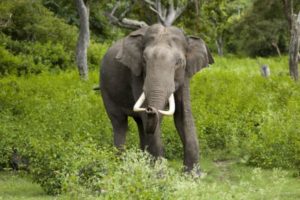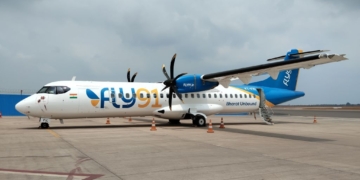If taking a vacation has been on your mind for long and you are looking for a short vacation to recharge yourself before jumping into yet another round of brain storming session in closed board rooms, it’s time you take a look at the amazing richness of Wildlife in Karnataka. The Western Ghats with thick evergreen forests and the jungle tracks south of the Vindhyas or the scrub jungles of the plains teem with a variety of flora and fauna. The state is home to 5 National parks and 21 wildlife sanctuaries – some popular some not so. Here’s a look at some of them…
Priyanka Saxena Ray
Karnataka state has 5 National parks and 21 wildlife sanctuaries, few of well known among them are Bandipur National Park, Bannerghatta National Park and Nagarhole National Park. The state also has Peacock Sanctuary, Biological Park, Blackbuck Sanctuary, 5 best bird sanctuaries and Tiger Reserve. Some of the national parks and wildlife sanctuaries are part of the niligiri biosphere reserve – here’s a look at some of them –
Nagarhole National Park
A part of the Nilgiri Biosphere Reserve, Nagarhole National Park has been blessed with a serene lake and rich, exotic wildlife. One of the best wildlife reserves of Karnataka, this national park has the attached Kabini Lake that becomes an important strip for the animals who travel here and there through the adjoining Bandipur National Park. Because of being more popular than Bandipur, it always attracts a higher footfall. Spread in an area of 642.2 square km, Nagarhole has various attractions like thick forests, open sightseeing spaces and a bank of the river. All this offers a wonderful wildlife-viewing experience. Animals like Common langur, Tiger, Gaur, Elephant, Bonnet Macaque, Dhole and Barking deer along with as many as 270 avifauna species call it their home.
Due to heavy rains, the park is closed between the month of July and October. The hunter-gatherer Jenu Kuruba tribe is the old inhabitant of this area. They still live in the park in spite of the fact that the government has tried to relocate them. For wildlife-viewing, the best time to visit Nagarhole national park is from April to May, however, as far as climate is concerned, it is between November and February.
Brahmagiri Wildlife Sanctuary
The Brahmagiri wildlife sanctuary is located in the Kodagu (Coorg) district, Karnataka state and is part of the Western Ghats. It is situated on the border between Wyanad District of Kerala state on the south and Kodagu District in Karnataka on the north side. The sanctuary derives its name from the highest point, the Brahmagiri peak, which is 1607m in height. It covers an area of about 181 km.
The area has mainly evergreen and semi-evergreen forest, and in the higher altitudes, there are grasslands with shola forest patches. Bamboos are well represented in these forests. The top of Brahmagiri Hill is well forested and has a lot of wildlife.
Cauvery Wildlife Sanctuary
Cauvery Wildlife Sanctuary is a protected area located in the Mandya, Chamarajanagar and Ramanagar districts of Karnataka. The Cauvery River passes through its midst. It was established in 1987.The Sanctuary spans an area of 1027.535 square kilometers. On its east, it adjoins Dharmapuri forest division of Tamil Nadu state. The major portions of the forests are of South Indian dry deciduous type. It is home to mammals like elephant, wild boar, leopard, dhole, spotted deer, barking deer, four-horned antelope, chevrotain, common langur, bonnet macaque, honey badger (ratel), malabar giant squirrel, smooth-coated otter and grizzled giant squirrel. The river cauvery also houses various species of reptiles like the Mugger crocodile,Indian mud turtles, and various species of snakes. This is also one of the few places to find mahseer fish. The central and eastern parts of the sanctuary are well forested, Hogenakal falls (Smoking rock in Kannada), Mekedatu (Goats leap), Sangam (The point where the Arkavathi river joins the Cauvery) and Muthathi (The religious place where lord Anjaneya temple is situated) are of cultural, historical and tourist interest. The eastern part of the sanctuary is completely bounded by the state of Tamilnadu. Four wildlife ranges have been created for this sanctuary i.e. Kanakapura, Hanur, Cowdally and MM Hills wildlife ranges.

Bandipur National Park
Once the private hunting grounds of the Maharajas of Mysore, Bandipur National Park spreads in a forested jungle of 874 square kilometers. One of the most popular wildlife reserves in the region, it is a part of the Nilgiri Biosphere Reserve. Today, the national park is home to more than 100 species of mammals including elephant, tiger, spotted deer, Indian bison, langur, sloth bear, mongoose, sambar and wild dog. It is also ideal for bird watching as around 350 species of birds call Bandipur their home.
Morning and evening bus safari and van safari are two ways to view wildlife. Though the park is open all throughout the year but the best time is from March to June and from September to November. Bandipur shares boundaries with Nagarhole National Park, Mudumalai National Park, and Wayanad Wildlife Sanctuary. The national park is 80 km southwards of Mysore, placed on the Mysore-Ooty Highway. The national park can be reached from Mysore as well as Bengaluru.
Dandeli Wildlife Sanctuary
Dandeli Wildlife Sanctuary is located in Uttara Kannada District of Karnataka state in India. The sanctuary covers an area of 866.41 km2 (334.52 sq mi). Along with neighbouring Anshi National Park (339.87 square kilometres (83,980 acres)), the sanctuary was declared part of the Anshi Dandeli Tiger Reserve in 2006. Karnataka state government has officially notified the Dandeli Elephant Reserve under Project Elephant on 4 June 2015. The elephant reserve is spread over 2,321 sq km, including 475 sq km as core and the remaining as buffer areas. This is the second elephant reserve in Karnataka after Mysuru Elephant Reserve, which was declared in 2002. Dandeli Wildlife Sanctuary is a birdwatchers paradise, housing nearly 200 species of Birds, most famous for the Great Hornbill (Great Indian Hornbill or Great Pied Hornbill) and the Malabar Pied Hornbill. It is also the only known Tiger Reserve in India to report frequent sightings of the elusive Black Panther. It is also know to house the Indian Sloth Bear, the Indian Pangolin, the Giant Malabar Squirell, Dhole, the Indian Jackal and the Muntjac (Barking Deer). Sightings of the Indian Elephant and the Indian Peafowl are pretty common. The King Cobra and the Maggur (Indian Crocodile) are the prime reptilians in Dandeli Wildlife Sanctuary. The forests in Dandeli are a mixture of dense deciduous trees interspersed with Bamboo and Teak plantations.
Ranganathittu Bird Sanctuary
Located at a distance of just 16 km from Mysore, Ranganathittu Bird Sanctuary is a heaven for bird watching enthusiasts. One of the most popular bird sanctuaries in Karnataka, it is placed on the banks of River Kaveri, spread on 6 isles of the crocodile infested backwaters. The sanctuary is also nesting grounds for around 170 species of birds. It is popularly known as the ‘Pakshi Kashi of Karnataka’
Ranganathittu Bird Sanctuary does not only have the resident birds various kinds of migratory birds from Australia, Siberia, and North America can also be spotted here. This forest area was declared a bird sanctuary by popular ornithologist Dr Salim Ali, in the year 1940. During bird watching in the sanctuary you can spot colourful avifauna species such as egret, peacock, whistling duck, kingfisher, pelican, Asian open bill storks, snake bird, spoonbills, Oriental darters, white Ibis, partridge and so on.
One of the best things to do at Ranganathittu bird sanctuary is ranger guided boat tours. As the boats are set afloat on the waters of River Kaveri, you can spot several colourful species of birds. There are as many as 170 species of birds, lizards, mongoose, common otter, bonnet macaque, flying fox and freshwater crocodiles can be spotted here during boat safari.
Someshwara Wildlife Sanctuary
Situated in the Western Ghats, the Someshwara Wildlife Sanctuary covers an area of 88.4 sq km in Udupi District, Karnataka. It was declared a Wildlife Sanctuary in 1974, and abounds in wild critters typical to South-east Asia. The Someshwara Wildlife Sanctuary is divided into two parts, each separate from the other. The smaller section is situated towards the southwest of the larger section. The sanctuary is mostly made up of evergreen forests, semi evergreen and moist deciduous forests. It is situated very close to the much bigger Kudremukh National Park. However, that does not in any way take away from the beauty of the sanctuary or the amount of wild flora and fauna found here.


































